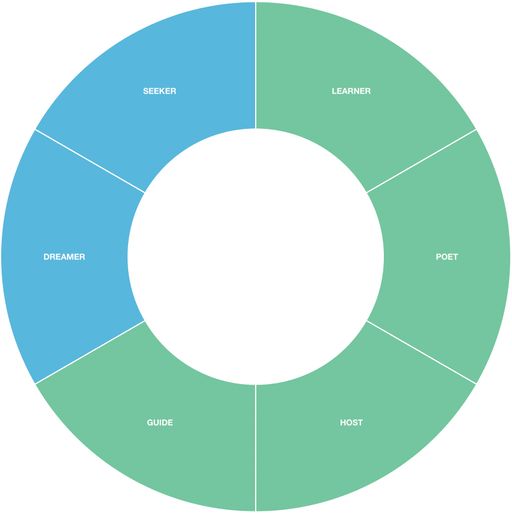
REFLECT AND CELEBRATE: What gives life and how can we celebrate it?
Describe and cherish the best of what is. In this phase we gather info to better understand specific events, situations, or contexts. We choose the positive moments and gifts as the focus of our inquiry. We wait for insights and learnings.
Quick wins: Core Gifts
This circle chart displays the six Core Gifts as slices in a ring, and their relative weight. The Gifts are your core success factors. Each slice displays a different facet that total 100%. These Gifts come naturally to you and focusing on them is the shortest route to achieve progress and ultimately success. This graph highlights your core success factors and it’s relative weight between.
Celebrating strengths
This Graph depicts the current strengths, the know-how, the collective abilities of the members and the community. The Core Gifts is what informs all the steps in the process. We build on these collective forces to determine what we can do more of to move closer to our preferred futures.
Appreciative Interviews
To begin the process, ask people to find a reasonably friendly stranger, preferably someone they interact with the least. They are to interview each other for about 10–20 minutes each.
- Ask them to pay close attention when listening and to assume they are listening to a great story.
- They should strive to help their interview partner recount more details of the story being told.
- Also listen for their partner’s enthusiasm in telling that story.
- Under no circumstances are participant-listeners to interrupt the story with comments or a story of their own.
After the allotted time, ask people to switch roles. The listeners now become the interviewees and tell their stories.
Describing and Appreciating the best of what is
People interview each other based on a variation of the following generic core questions:
- Peak Experience: Think back on your experience with … (your FaithStyle Facets). Remember a time when you felt most energised and most proud … (of your Core gifts). Tell a story about that time. What happened? What were you doing? What were others doing? What contributed to the success you experienced? Tell the story giving some detail.
Sharing the stories in groups
After the paired interviews, we share our stories in groups of six. We do not share their own story. We rather tell the friendly stranger’s story. Listening to one’s story told by someone else celebrates our experience and deepens one’s understanding of the experience. We all listen for themes as we hear the group’s stories.
The power of Core-Gift-Stories
Stories have the ability to remind us of what success looked like and felt like. Stories aid us to relive the event and the feelings it generated. Stories help remember that we can be successful, things can work, and that we have the capacity to bring life and energy to our work. Stories reinforce the notion that as co-contributors to the community’s goals, we often have more in common than we think. Stories are useful data about dynamic moments of excellence.
Unconditional Positive Questions
Core Gift questions go straight to ‘the whole point’ of faith. They’re about what is good and what works best. Together we look for what’s making something work. Then we ask what’s behind that gift or success.
- Core Question:
- Values: Without being modest, what do you value most about yourself? . . . About your FaithStyle Facets? . . . About your contribution?
- Telling-the-story-questions: What we do at our best
- “What do we do exceptionally well?” and “What can we learn from that?”
- “What has been a high-point experience in your community/group/life when you felt most alive, successful, and effective?”
- Implications-for-identity-questions: Who we are at our best
- Reflect on how your FaithStyle facet functioned in the past and present and to describe them in more detail. What was good about that Facet? What was particularly positive/memorable about this Facet? What sticks in your mind?
- What-is-God-up-to-questions: God’s prefered future unfolding
- What about the experience of that Facet was most valuable to you? What were the best things about this Facet when working together? How did your group have an impact on your Facet?
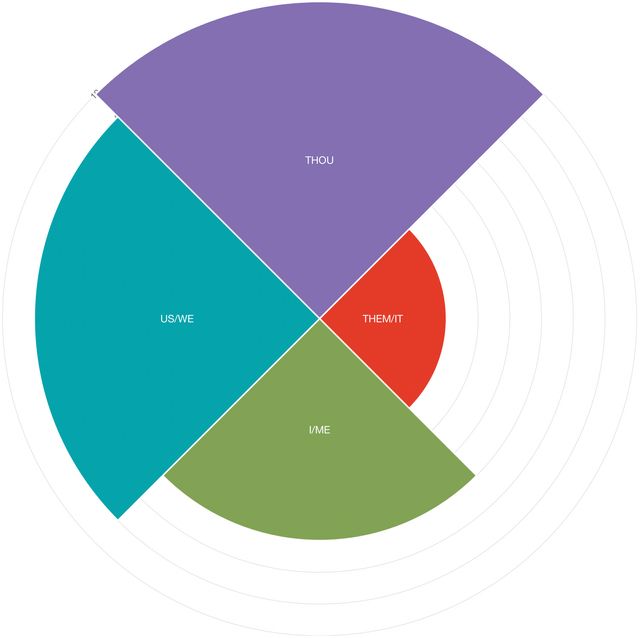
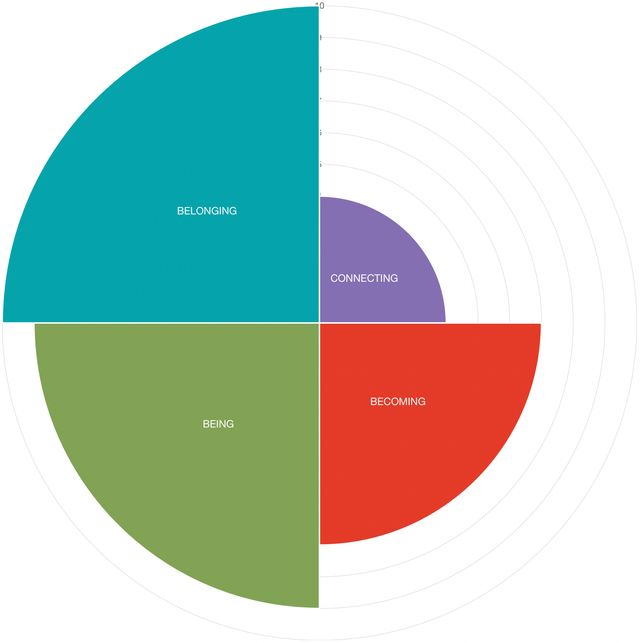
LISTEN AND DISCERN: What is the context calling for and what might be?
Innovating and envisioning the possible. In this phase we seek to interpret and explain why certain actions and patterns are taking place. We generalise the gifts of the Spirit into an image of how the community would function if these gifts (facets) were fully functioning. If they were truly alive.
Relationship strengths
This star chart illustrates your FaithStyle Relationships. The further a sector extends from the center, the stronger the collective awareness. This chart shows the relationships that are top of mind for your community. Tasks and projects that strengthen these relationships have the best chance of succeeding. (polar area chart)
Dimension strengths
This star chart illustrates your FaithStyle Dimensions. The further a sector extends from the center, the stronger the collective awareness. Dimensions show the freedoms we are seeking. Tasks and projects that nourish these ‘freedoms’ have the best chance of succeeding. (polar area chart)
Project list
We use this graph to design what projects and inputs can be made to develop our community’s capacity to bring the dream of a beautiful trustworthy world to life. We do this together.
Innovating and envisioning the possible
At this stage of the process we ask people to describe the themes that emerged from their stories. Seeking themes from stories is a means for initiating group reflection. Listen how these themes correlate with the relationship and dimension strengths. These themes might be seen as “causes of success.” In this phase we seek to interpret and explain why certain actions and patterns are taking place. We generalise the gifts of the Spirit into an image of how the community would function if these gifts were fully functioning. Listening and visioning questions are designed to inspire images of the future.
After participants reflect on the themes from the stories, they share the values and wishes that are ‘locked up’ in their FaithStyle Facets. This helps us:
- identify shared values
- appreciate others’ ideas about how to fulfil those values in community
- exposed us to others’ values that may not be a priority for me
- help us see what others need if they are to excel.
- makes explicit the deep motivation of those who are part of our community.
- clarifies the standards people use to judge their experiences
- verbalise the way people understand purpose, performance, and impact.
Core question:
We are corporately seeking to develop a vision for the future of the community. People are first invited to reflect individually on this question:
Imagine that it is 2–3 years from now and you are preparing for an awards ceremony to celebrate your community’s accomplishments. An important newspaper wishes to write an article on this out of the ordinary feat. You are so proud to be part of the work you have done. What is happening to make you proud? What are people saying? What is happening internally in the program or community? What changes and/or events made this success possible? How did we use people’s FaithStyle Facets to achieve this?
People may also be encouraged to draw pictures of their visions. These images are particularly effective at tapping into a group's creative energy. Sometimes it is more effective than words in conveying an idea.
Unconditional Positive Questions
Listening and visioning questions are designed to inspire images of the future for a community, team, or individual. It guides us towards positive action through creative imagining of possibilities. It unlocks hope that we can achieve these through our strengths.
- Telling-the-story-questions: What we do at our best
- “Without being humble, what do you value most about yourself, your group, and your community?”
- Implications-for-identity-questions: Who we are at our best
- “What does your ideal future look like for our group?”
- “What would be your best aspirations for our community in five years?”
- What images (Facet) did you envision that helped you make an impact?
- How do you feel those images (Facet) contributed to your success as a group?
- What-is-God-up-to-questions: God’s prefered future unfolding
- How did you (or your Facets and actions) have an impact on people’s actions?
- What was unexpected (or most memorable) about this experience?
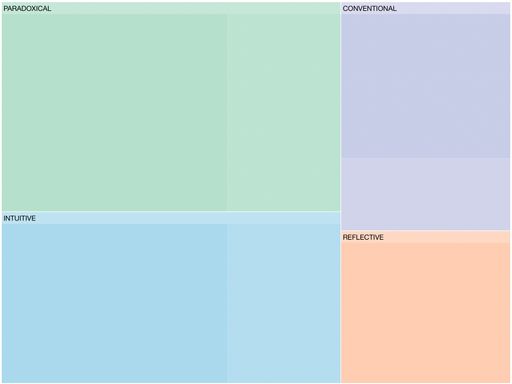
PLUNGE AND DISCOVER: What is working and how can we do more of that? Where should we risk?
Mindset patterns
This tile chart illustrates the underlying mindset in your collective FaithStyle. Each faith Perspective and its parts are represented by a set of rectangles. This overview shows the distinctly personal way you create meaning. The approach of your ministry should be guided by the reality of your current FaithStyle because this mindset shapes the ways in which you live in the real world.
Spotting the emerging patterns
We use this Graph to inquire into the high-point experiences, sparkling events, alternative stories and identity strengths. We will now attempt to ‘translate’ our FaithStyle Capabilities into a clear vision. We encourage each other to be bold but realistic. We want to unlock our Christian imaginations
Experimenting and learning
We are now integrating our past successes and visions for the future into concrete actionable possibilities. We now discover how change can occur and what needs to happen to make it a reality. In a year's time:
- Use your mind's eye and think forward to an ideal function for your organisation, in one year’s time.
- What is happening? Who is doing what? What does your input look like?
- What short-term goals have we achieved? What strengths of your Facets have we leveraged to get us there? What can you say is different? What’s new and exciting?
Seeing the possibilities
Look at the top scores in your most prominent Perspective. As a group choose one or more Facets to work on. In this phase we use this Graph to share images and co-creation possibilities. Together we start discerning what the co-created future might look, sound, and feel like when the Gore Gifts come to life. Once we have selected a Facet, we develop provocative propositions. These statements are then written in the present tense and are affirmative. They are intended to bridge the best of “what is” with participants’ visions of “what might be.” These “How might we” statements should stretch our imagination. They must go beyond the obvious. They should reimagine our community’s social architecture. A social architecture represents things in an organisation that support the implementation of the future desired state.
Unconditional Positive Questions
- Telling-the-story-questions: What we do at our best
- How did your FaithStyle Perspective and its strengths play a role in your community’s (your) success?
- How did collaboration and cooperation influence the impact of your FaithStyle?
- What exact Facets were you and your group members exercising during the project? How can those Facets help you achieve similar successes moving forward?
- Implications-for-identity-questions: Who we are at our best
- How was your current experience similar to other successes you’ve been a part of?
- Imagine that we’re exactly where we want to be as a community, in three years time. What are the three biggest things we’ve accomplished between now and then?
- What are some ways we have brought this to life? How did our FaithStyle Facets help? What good things are we known for in the community?
- What-is-God-up-to-questions: God’s prefered future unfolding
- What new trends are shaping how we function as a community?
- How do you feel they will impact us in reinventing God’s prefered future?
- Picture our ideal future as a renewing, creative organisation. How are we interacting with one another and with people we serve? What’s the thing you’re most proud of having made an impact in your context?
- In a year's time:
- Use your mind's eye and think forward to an ideal function for your organisation, in one year’s time.
- What is happening? Who is doing what? What does your input look like?
- What short-term goals have we achieved? What strengths of your Facets have we leveraged to get us there? What can you say is different? What’s new and exciting?
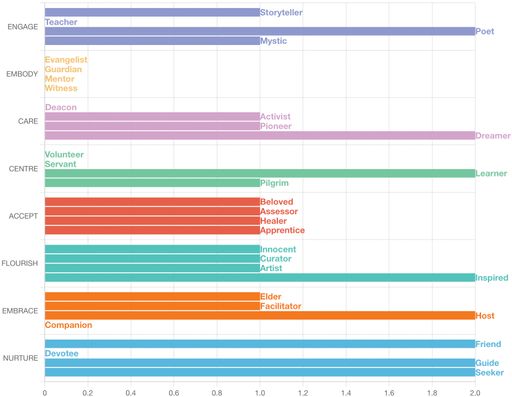
CLARIFY AND FOCUS: What should be? How can we realign?
Co-constructing and building the ideal. In this phase we raise guiding questions from the perspectives of faith, tradition, ethics and other fields. We develop ideas on how to integrate the gifts of FaithStyles into the community's structures, systems and planning.
Distribution of gifts
This length of lines in this bar chart represents the strength of each FaithStyle Facet in your Collective FaithStyle. It illustrates the many-sidedness of your gifts and how it is distributed between the modes of faith (y-axis). Use this to unlock the unexplored potential in your community and use the strengths of members.
Facet Lens
The Facet graph is a shortcut to seeing the preferred Collective Faithstyles. The FaithStyles that got the highest scores are the preferred framework for the group of community to help them with ultimate meaning. They use these Facets to make sense of their world, relationships and context. In this phase we use this Graph and the collective, as well as individual FaithStyles to share images and co-creation possibilities. Together we start discerning what the co-created future might look, sound, and feel like when the Gore Gifts come to life.
- Wishes: If you had three wishes for this community/program to make more of these exceptional experiences possible, what would they be?
Our wishes reveal our beliefs regarding:
- Aspects of the community that need improvement
- Aspects of the program or community that people interested or concerned in what we do would like explored with more attention
Ministry Focus Lense: Having a shorter list of things to do.
We use this graph to design what projects and inputs can (practically) and should (morally) be made to build community capacity to bring the dream of a beautiful trustworthy world to life. We do this together.
Unconditional Positive Questions
What are the core factors that make your community function at its best, when it feels a great place to be in, and without which it would cease to exist?
- Telling-the-story-questions: What we do at our best
- What precise strengths (or Facet) were you and your teammates leveraging during your project/functioning? What are some other occasions that you’ve used those particular strengths?
- How might you use them in the future for other positive outcomes?
- Implications-for-identity-questions: Who we are at our best
- How would you describe the dynamics (group energy) of your group? What roles (Facets) were particularly useful? What made them effective? In what ways did you feel your group members supported you?
- What-is-God-up-to-questions: God’s prefered future unfolding
- Commitment to our collective goals: Think of a congregation in which you believe believers have a sense of ownership around what they do. What does this congregation do that you feel is so successful in encouraging ownership?
- What does your congregation do that is similar or different?
- Imagine your ideal future for our community. As a community, we’re best in creative innovation around ….(Facet). What is so wonderful about who we are and what we do?
- What does it look like? What is really great about the way we work together across the community? How do our groups function?
- How are our Facets being used to make innovation so alive?
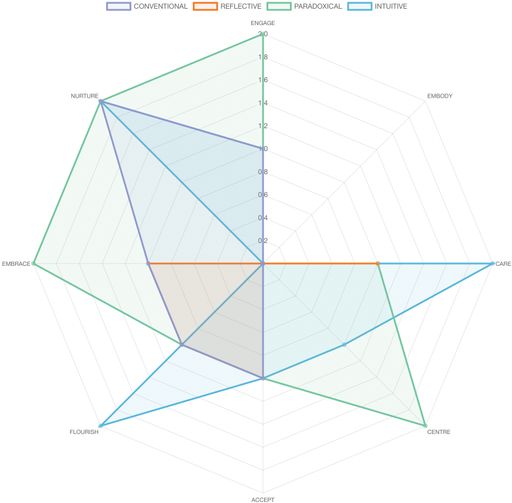
IMPLEMENT AND PRACTICE: How to empower, learn, adjust, and improvise?
Executing and sustaining with excellence. In this phase we form an action plan and undertake specific steps that seek to shape the events, situations, or context in helpful directions.
FaithPrint
This radar chart shows the relative strength and links between the different FaithStyle Facets. Faith Perspectives are shown in different colours. This is a complete visual image of your FaithStyle.
Discovering roles
This chart shows the interrelatedness and relative strength between the different FaithStyle Facets. Each Faith Perspective is shown in a different colour. This Graph gives us all the information we need to implement our agreed commitments. We discover where the gifts are that can guide us to learning, innovation, and follow-through. Executing and sustaining with excellence. In this phase we focus on action and specific steps that seek to shape the events, situations, or context in helpful directions. We take action in line with the Core Gifts and emerging insights. Discovering the role of members. We ask individuals to self-organise around a topic they choose based on their individual Fingerprint lens. They are invited to declare their intended actions.
Guiding questions:
- How will we learn about the impact of our Core Gifts? Questionnaires? Appreciative listening? Open feedback sessions?
- How will we celebrate each one’s FaithStyle contributions? How might recognition inspire ongoing action?
- What can we do to keep people aware of and excited about an ongoing shift of emphasis?
- How shall we self-organise? What are our conditions for self-organised action? Time? Resources? Domains?
- How will we support success? What resources, support, and expertise do people need to keep on bringing their FaithStyle Facits into play? Who are the best people to provide what’s needed? steps for implementing?
Unconditional Positive Questions
Positive innovation happens most effectively where ‘narrative-rich communication’ is present. We invite storytelling in a creative, supportive, positive environment. This motivates us to share stories, give natural responses, and speak openly.
- Telling-the-story-questions: What we do at our best
- Reflect back on a leading experience that really made you feel engaged or alive. These questions are about ‘what’s good’, ‘what’s worked’, and ‘what’s working’, both in the past and in the present. What happened? What factors made this positive experience possible?
- How can you build on your learnings (and early successes) in a way that will help your community succeed?
- Implications-for-identity-questions: Who we are at our best
- How might these precise Facets help your group succeed again in the future?
- What particular strengths can you focus on more as a group, for similar positive results?
- Which of these Facets might be useful in continuing your group’s success?
- What strengths (Facets) could you develop further for continued positive outcomes? What can others help you with to develop these facets and succeed?
- What-is-God-up-to-questions: God’s prefered future unfolding
- If you had three wishes for your community, (your group or yourself), what would they be?”
- What stories or strengths (Facets) could you apply more widely to build on that success?
- Imagine you’ve woken up in the best possible future for your community. These questions enable future-oriented Christain imagination. Our community has come up with an amazing approach to do things differently, and things are working exactly as we’ve always hoped. What’s great about it?
- Describe it—what’s happening in different areas/aspects of the community? What’s different? What are people doing?
- How are they using their FaithStyle facets? How are they approaching creating God’s future?
